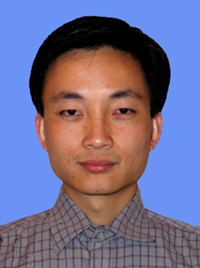
Name: LIU Honggang
Title: Professor
Phone: +86-10-8299 5675
Fax: +86-10-6202 1601
Email: liuhonggang@ime.ac.cn
Address: 3 Bei-Tu-Cheng West Road, Beijing 100029, China
RESEARCH INTERESTS
Prof. Liu’s current research interests span the areas of emerging semiconductor devices, micro-/nanofabrication, analog/mixed-single ICs and renewable energy technologies. Particular interests include high mobility Ge/III-V CMOS on silicon, terahertz transistors and ICs as well as high efficiency photovoltaic devices.
EDUCATION
Ph.D., Microelectronics and Solid-State Circuit (2003)
Institute of Microelectronics, Chinese Academy of Sciences
Dissertation: “Device Modeling, MMIC Design and Fabrication Process of 10 Gbit/s InGaP/GaAs HBT EAM Driver ICs for DWDM Optical Networking”
PROFESSIONAL EXPERIENCE
From 2003 to 2005, he conducted postdoctoral research on mm-wave InP/GaAsSb DHBTs at Simon Fraser University, BC, Canada. In 2006, he joined Swiss Federal Institute of Technology (ETH Zurich), Switzerland, as a research associate responsible for terahertz transistors development and demonstrated 0.3 micron InP/GaAsSb DHBTs with cutoff frequencies above 600 GHz (exceeding 700 GHz at cryogenic temperature) and a BVCEO of 4.2 V simultaneously. In 2008, he worked with University of Toronto/ARISE Tech joint photovoltaic laboratory for high-efficiency Si-based solar cells development. Currently, he is a professor working with Institute of Microelectronics, Chinese Academy of Sciences, Beijing, China.
SELECTED PUBLICATIONS
1) H.G. Liu, H. D. Chang, B. Sun, “Extrinsic Base Surface Passivation in Terahertz GaAsSb/InP DHBTs Using InGaAsP Ledge Structures”, IEEE Transaction on Electron Devices, 58(2), 2011, pp. 576.
2) H.G. Liu et al, “PECVD Amorphous Silicon Sub-oxide films for Surface Passivation of Silicon Solar Cells”, 10th IEEE International Conference on Solid-State and Integrated Circuit Technology, 2010, Shanghai.
3) H.G. Liu, O. Ostinelli, Y.P. Zeng and C.R. Bolognesi, “Emitter Size Effect and Ultimate Scalability in InP:GaInP/GaAsSb/InP DHBTs”, IEEE Electron Device Letters, 29(6), 2008, pp. 546-548.
4) H.G. Liu, Y.P. Zeng, O. Ostinelli and C.R. Bolognesi, “600 GHz InP/GaAsSb/InP DHBTs Grown by MOCVD with a Ga(As,Sb) Graded-Base and fT× BVCEO > 2.5 THz-V at Room Temperature”, IEEE International Electron Devices Meeting (IEDM), 2007, pp. 667-670, Washington DC, USA.
5) H.G. Liu, O. Ostinelli, Y.P. Zeng and C.R. Bolognesi, “High-Current-Gain InP/GaInP/GaAsSb/InP DHBTs with fT = 436 GHz”, IEEE Electron Device Letters, 28(10), 2007, pp. 852-855.
6) H.G. Liu, O. Ostinelli, Y.P. Zeng and C.R. Bolognesi, “High Gain Arsenic-Rich n-p-n InP/GaAsSb DHBTs with fT > 420 GHz”, IEEE Transactions on Electron Devices, 54(10), 2007, pp. 2792-2795.
7) H.G. Liu, S.P. Watkins and C.R. Bolognesi, “Type-II InP/GaAsSb DHBTs with 15 nm Base and 384 GHz fT and 6-V BVCEO”, IEEE Transactions on Electron Devices, 53(3), 2006, pp. 559-561.
8) C.R. Bolognesi, H.G. Liu, N.G. Tao, L. Zheng, X. Zhang, S.P. Watkins, “The InP/GaAsSb type-II heterostructure system and its application to high-speed DHBTs and photodetectors: physics, surprises, and opportunities”, IEEE International Electron Devices Meeting (IEDM), 2005, Digest pp. 779-782.
9) C.R. Bolognesi, H.G. Liu, N. Tao, X. Zhang, S. Bagheri-Najimi and S.P. Watkins, "Neutral base recombination in InP/GaAsSb/InP double-heterostructure bipolar transistors: Suppression of Auger recombination in p+ GaAsSb base layers," Applied Physics Letters, vol. 86, 2005, pp. 253506-1-3.
10) Nick G.M. Tao, H.G. Liu, C.R. Bolognesi, "Surface Recombination Currents in "Type-II" NpN InP-GaAsSb-InP Self-Aligned DHBTs", IEEE Transactions on Electron Devices, 52(6), 2005, pp. 1061-1066.
11) H.G. Liu, N. Tao, S.P. Watkins, C.R. Bolognesi, "Extraction of the average collector velocity in high-speed “Type-II” InP-GaAsSb-InP DHBTs", IEEE Electron Device Letters, 25(12), 2004, pp. 769-771.
12) H.G. Liu, J.Q. Wu, N. Tao, A.V. Firth, T.W. MacElwee, C.R. Bolognesi, "High-performance InP/GaAsSb/InP DHBTs grown by MOCVD on 100 mm InP substrates using PH3 and AsH3", Journal of Crystal Growth, 267, 2004, pp. 592-597.











